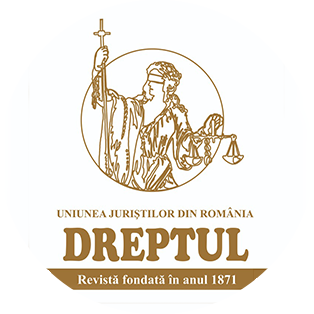-
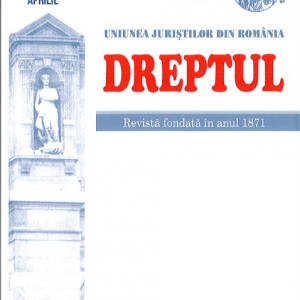 The study is considered to be a valuable examination from a theoretical perspective of recent judicial practice, an examination which often shows argumented critical accents, all relating to the offence newly introduced in the Criminal Code in force since 1 February 2014, respectively the violation of the professional headquarters. One by one, illustrating concrete cases from the practice of the Romanian courts, there are identified difficulties arising from the interpretation and application of the norm of incrimination included in Article 225 of the Criminal Code. Such elements are the following: the notion of „headquarters”, the correct identification of the injured person or the adequate identification of the social value protected by the norm of incrimination. The study is valuable in that it argues the opinions expressed by consistently invoking some aspects included in the preambles of some decisions of the European Court of Human Rights.
The study is considered to be a valuable examination from a theoretical perspective of recent judicial practice, an examination which often shows argumented critical accents, all relating to the offence newly introduced in the Criminal Code in force since 1 February 2014, respectively the violation of the professional headquarters. One by one, illustrating concrete cases from the practice of the Romanian courts, there are identified difficulties arising from the interpretation and application of the norm of incrimination included in Article 225 of the Criminal Code. Such elements are the following: the notion of „headquarters”, the correct identification of the injured person or the adequate identification of the social value protected by the norm of incrimination. The study is valuable in that it argues the opinions expressed by consistently invoking some aspects included in the preambles of some decisions of the European Court of Human Rights. -
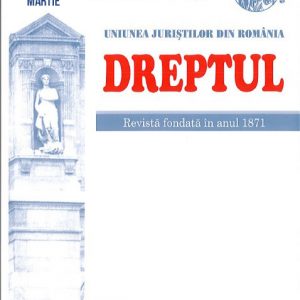 Ideea de reparație este, cum scria un autor, „una din cele mai vechi idei morale ale omenirei” (G. Ripert, La règle morale dans les oblig. civiles nr. 121, p. 223). În decursul timpurilor ea a suferit o serie de transformări, a parcurs mai multe etape, rezumate în cele 4 subtitluri ale studiului de față, care urmărește numai să schițeze în linii mari sensul acestei atât de interesante evoluții, care are semnificația drumului penibil al însăși ideei de Dreptate. Noțiunea de răspundere, în adevăr, se situiază în centrul tuturor instituțiunilor juridice care au de obiect reglementarea raporturilor între indivizi în societate, având un rol regulator și sancționator, întru cât tinde la păstrarea echilibrului rupt prin actele ilicite, fie că sunt violări de obligațiuni contractuale, fie că au caracterul și mai grav al călcării unor norme de conduită, pe pare societatea însăși le impune și îndeosebi acea normă negativă universală de neminem laedere, care constitue în esență principiul din care decurge însăși ideea de răspundere.
Ideea de reparație este, cum scria un autor, „una din cele mai vechi idei morale ale omenirei” (G. Ripert, La règle morale dans les oblig. civiles nr. 121, p. 223). În decursul timpurilor ea a suferit o serie de transformări, a parcurs mai multe etape, rezumate în cele 4 subtitluri ale studiului de față, care urmărește numai să schițeze în linii mari sensul acestei atât de interesante evoluții, care are semnificația drumului penibil al însăși ideei de Dreptate. Noțiunea de răspundere, în adevăr, se situiază în centrul tuturor instituțiunilor juridice care au de obiect reglementarea raporturilor între indivizi în societate, având un rol regulator și sancționator, întru cât tinde la păstrarea echilibrului rupt prin actele ilicite, fie că sunt violări de obligațiuni contractuale, fie că au caracterul și mai grav al călcării unor norme de conduită, pe pare societatea însăși le impune și îndeosebi acea normă negativă universală de neminem laedere, care constitue în esență principiul din care decurge însăși ideea de răspundere. -
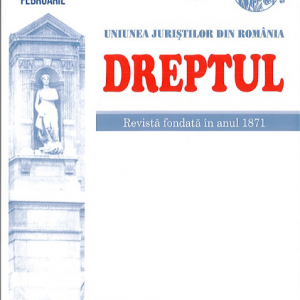 The company’s entry into insolvency proceedings may be the result of an unfavourable economic situation or the abusive or negligent attitude of the governing bodies may contribute to this outcome. Sometimes people outside the company may have exercised a direct or indirect control of the company’s activities and be liable for insolvency. In these last hypotheses, the legislator chose to sanction insolvency peers who are held patrimonial alongside the insolvent society in order to satisfy creditors’ claims. As a rule, the former statutory administrator is the one who is called upon to respond to the mismanagement of the company’s business. Taking responsibility for this person implies the making of a claim for property liability which is the subject of a separate litigation in the company’s insolvency proceedings. This distinct dispute is settled in a contradictory procedure, with the administration of evidence in order to establish the meeting of the conditions of civil liability under Article 169 of the Law No 85/2014. When, prior to the opening of insolvency proceedings or during the course of the proceedings, whether or not an application for the liability of the statutory administrator was initiated, the question arises as to what happens when the death of the statutory administrator occurs. Such a request to obtain a patrimonial response in conflict with the heirs of the predecessor administrator may be made or continued or the liability is limited to the person of the deceased and a decision cannot be made to order the successors to answer for de cujus clerical errors.
The company’s entry into insolvency proceedings may be the result of an unfavourable economic situation or the abusive or negligent attitude of the governing bodies may contribute to this outcome. Sometimes people outside the company may have exercised a direct or indirect control of the company’s activities and be liable for insolvency. In these last hypotheses, the legislator chose to sanction insolvency peers who are held patrimonial alongside the insolvent society in order to satisfy creditors’ claims. As a rule, the former statutory administrator is the one who is called upon to respond to the mismanagement of the company’s business. Taking responsibility for this person implies the making of a claim for property liability which is the subject of a separate litigation in the company’s insolvency proceedings. This distinct dispute is settled in a contradictory procedure, with the administration of evidence in order to establish the meeting of the conditions of civil liability under Article 169 of the Law No 85/2014. When, prior to the opening of insolvency proceedings or during the course of the proceedings, whether or not an application for the liability of the statutory administrator was initiated, the question arises as to what happens when the death of the statutory administrator occurs. Such a request to obtain a patrimonial response in conflict with the heirs of the predecessor administrator may be made or continued or the liability is limited to the person of the deceased and a decision cannot be made to order the successors to answer for de cujus clerical errors. -
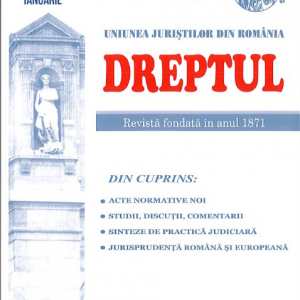 Arbitration is an alternative private jurisdiction to the State jurisdiction, in order to settle civil litigations. The private character of this jurisdiction is marked by the decisive role of the autonomy of will of the parties in the organization and conduct of arbitration, in the establishment of the arbitral tribunal, in which the arbitrators nominated by the parties are not designated by a public authority or by a public institution. The arbitrary source of the arbitration merges with the judicial nature conferred by the judgment pronounced, which enjoys the authority of res judicata and is executed in exactly the same way as any judgment pronounced by a state court. As a result, arbitration has a dual, contractual nature, through its source, and jurisdictional, through the judgment pronounced. In the present study several objectives have been pursued on the subject discussed, namely establishing the legal nature of the arbitral jurisdiction, the types of arbitration convention and its role, the elements of convergence between the arbitration clause and compromise, the formal requirements of the arbitration convention, its limits and the consequences and the exceptions from these limits in terms of trial, the conditions of validity of the arbitration convention, its effects and its effectiveness, the causes of cessation of the arbitration convention.
Arbitration is an alternative private jurisdiction to the State jurisdiction, in order to settle civil litigations. The private character of this jurisdiction is marked by the decisive role of the autonomy of will of the parties in the organization and conduct of arbitration, in the establishment of the arbitral tribunal, in which the arbitrators nominated by the parties are not designated by a public authority or by a public institution. The arbitrary source of the arbitration merges with the judicial nature conferred by the judgment pronounced, which enjoys the authority of res judicata and is executed in exactly the same way as any judgment pronounced by a state court. As a result, arbitration has a dual, contractual nature, through its source, and jurisdictional, through the judgment pronounced. In the present study several objectives have been pursued on the subject discussed, namely establishing the legal nature of the arbitral jurisdiction, the types of arbitration convention and its role, the elements of convergence between the arbitration clause and compromise, the formal requirements of the arbitration convention, its limits and the consequences and the exceptions from these limits in terms of trial, the conditions of validity of the arbitration convention, its effects and its effectiveness, the causes of cessation of the arbitration convention. -
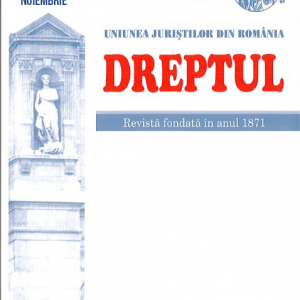 The Romanian Civil Procedure Code currently in force regulates, among others, the cross-appeal and the caused appeal, but these remedies are not regulated in the hypothesis of the (extraordinary) second appeal. The new Romanian Civil Procedure Code (published on 15 June 2010, but not yet in force) enacts both the caused cross-appeal and the caused cross-second appeal. After presenting the new regulation, the authors consider that, while the cross-/caused appeal is justified (since the appeal is a devolutionary remedy), the cross-/caused second appeal is not justified, since it is not compatible with the specific nature of the extraordinary second appeal.
The Romanian Civil Procedure Code currently in force regulates, among others, the cross-appeal and the caused appeal, but these remedies are not regulated in the hypothesis of the (extraordinary) second appeal. The new Romanian Civil Procedure Code (published on 15 June 2010, but not yet in force) enacts both the caused cross-appeal and the caused cross-second appeal. After presenting the new regulation, the authors consider that, while the cross-/caused appeal is justified (since the appeal is a devolutionary remedy), the cross-/caused second appeal is not justified, since it is not compatible with the specific nature of the extraordinary second appeal. -
 This study, having as theme general and special observations regarding the new Romanian Civil Procedure Code (Law no. 134/2010), after some brief preliminary observations, proceeds to a more thorough analysis of the fundamental themes of this Code, namely: the accentuation of procedural liberalism; the quality of the civil procedure law; the right of access to justice; the uniform interpretation and application of the law by the courts; celerity in the civil trial; accentuation of the effectiveness of remedies at law; higher-quality valorization of enforcement orders.
This study, having as theme general and special observations regarding the new Romanian Civil Procedure Code (Law no. 134/2010), after some brief preliminary observations, proceeds to a more thorough analysis of the fundamental themes of this Code, namely: the accentuation of procedural liberalism; the quality of the civil procedure law; the right of access to justice; the uniform interpretation and application of the law by the courts; celerity in the civil trial; accentuation of the effectiveness of remedies at law; higher-quality valorization of enforcement orders. -
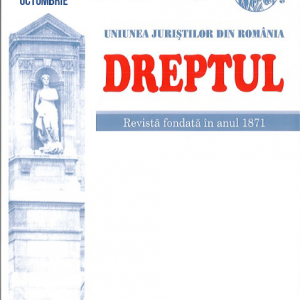 The author shows that, in the new regulation, the essential characteristic regarding the social danger entailed by the criminal action committed was removed from the definition of the crime. Instead, two new essential characteristics were introduced, namely: the action committed, which is provided by the criminal law, is unjustified and not imputable to the person having committed it. Also, reference is made to the correlation between the institution of the action provided by criminal law and the institution of the crime and the essential characteristics of the crime are examined.
The author shows that, in the new regulation, the essential characteristic regarding the social danger entailed by the criminal action committed was removed from the definition of the crime. Instead, two new essential characteristics were introduced, namely: the action committed, which is provided by the criminal law, is unjustified and not imputable to the person having committed it. Also, reference is made to the correlation between the institution of the action provided by criminal law and the institution of the crime and the essential characteristics of the crime are examined. -
 This study represents, in its essence, a micro-monograph regarding the right to image, a component of personality rights. In this respect, following a presentation regarding the “personality rights, in general”, the authors examine in detail the issue of the right to image (notion, basis, autonomy of the right to image, consent to the reproduction of one’s image, limits of the right to image, image contract, extinguishment of the right over image).
This study represents, in its essence, a micro-monograph regarding the right to image, a component of personality rights. In this respect, following a presentation regarding the “personality rights, in general”, the authors examine in detail the issue of the right to image (notion, basis, autonomy of the right to image, consent to the reproduction of one’s image, limits of the right to image, image contract, extinguishment of the right over image). -
 In this study, the author examines the constitutional and legal statute of the Romanian Court of Accounts, according to art. 140 of the Constitution of Romania (revised and republished on 31 October 2003), corroborated with a series of provisions contained in Law no. 94/1992 for the organization and operation of the Court of Accounts, as republished, for the second time, on 29 April 2009. To this effect, the authors examine the constitutional and legal statute of: the counselors of accounts; the personnel making up the executive management of the Court of Accounts and the Audit Authority, as well as the specialized personnel of the Court of Accounts (external public auditors).
In this study, the author examines the constitutional and legal statute of the Romanian Court of Accounts, according to art. 140 of the Constitution of Romania (revised and republished on 31 October 2003), corroborated with a series of provisions contained in Law no. 94/1992 for the organization and operation of the Court of Accounts, as republished, for the second time, on 29 April 2009. To this effect, the authors examine the constitutional and legal statute of: the counselors of accounts; the personnel making up the executive management of the Court of Accounts and the Audit Authority, as well as the specialized personnel of the Court of Accounts (external public auditors). -
 The continuous evolution of the social-economic life and the diversification of the forms of action of criminal groups have required, both as regards criminal offences and domestically, the regulation of the criminal liability of the legal entity. Since crime, in general and economic-financial crime, in particular, is continuously growing, the indictment of the legal entity as active subject of the criminal offence was considered useful. The Romanian lawmaker also did this, first, by amending the Criminal Code in operation by means of Law no. 278/ 2006 and then by drafting a new Criminal Code, according to the European democratic legislation. Given the importance of this institution for the Romanian criminal legislation, we considered useful to make a demanding radiography of this issue.
The continuous evolution of the social-economic life and the diversification of the forms of action of criminal groups have required, both as regards criminal offences and domestically, the regulation of the criminal liability of the legal entity. Since crime, in general and economic-financial crime, in particular, is continuously growing, the indictment of the legal entity as active subject of the criminal offence was considered useful. The Romanian lawmaker also did this, first, by amending the Criminal Code in operation by means of Law no. 278/ 2006 and then by drafting a new Criminal Code, according to the European democratic legislation. Given the importance of this institution for the Romanian criminal legislation, we considered useful to make a demanding radiography of this issue. -
 In this study, after a brief introduction on parental rights and obligations, the author examines, in the light of the legislation currently in force (Family Code – amended by Law no. 288/2007, and Laws no. 272/2004 and no. 273/ 2004), and in the light of the future Romanian Civil Code (published on July 24, 2009 but not yet into force), the status of parental rights and obligations, provided that the child has been legally entrusted to other persons, discussing, in this manner, with priority, the extent to which the parents are entitled to provide their consent to the marriage of their child (if the child is a minor) or to his/her adoption.
In this study, after a brief introduction on parental rights and obligations, the author examines, in the light of the legislation currently in force (Family Code – amended by Law no. 288/2007, and Laws no. 272/2004 and no. 273/ 2004), and in the light of the future Romanian Civil Code (published on July 24, 2009 but not yet into force), the status of parental rights and obligations, provided that the child has been legally entrusted to other persons, discussing, in this manner, with priority, the extent to which the parents are entitled to provide their consent to the marriage of their child (if the child is a minor) or to his/her adoption. -
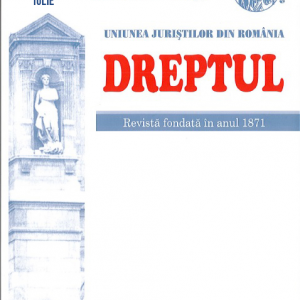 Taking into consideration the provisions of art. 1385, paragraph 4 of the new Romanian Civil Code (adopted and published in 2009, but not yet effective), according to which “if the illicit action caused the loss of the opportunity to gain an advantage, the remedy shall be proportional to the probability of gaining such advantage, by also taking into consideration the circumstances and the actual situation of the victim, and by considering the rich French case law in the field (in the matter of medical liability) the author believes that, in Romania, tort liability could exist even at present (in particular in case of malpractice, as regards medical liability) following the damage caused by losing the opportunity to gain an advantage. For this reason, the author presents in detail the compensation conditions for such damage.
Taking into consideration the provisions of art. 1385, paragraph 4 of the new Romanian Civil Code (adopted and published in 2009, but not yet effective), according to which “if the illicit action caused the loss of the opportunity to gain an advantage, the remedy shall be proportional to the probability of gaining such advantage, by also taking into consideration the circumstances and the actual situation of the victim, and by considering the rich French case law in the field (in the matter of medical liability) the author believes that, in Romania, tort liability could exist even at present (in particular in case of malpractice, as regards medical liability) following the damage caused by losing the opportunity to gain an advantage. For this reason, the author presents in detail the compensation conditions for such damage.
